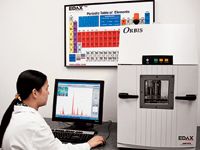Improved Sensitivity with the New Apollow XRF ML-50 Detector on the Orbis Micro-XRF Analyzer
Spectroscopy
Improved Sensitivity with the New Apollow XRF ML-50 Detector on the Orbis Micro-XRF Analyzer
The measurement of trace elements is important across a wide variety of materials characterization problems. When measuring small glass fragments collected from crime and accident scenes, forensics experts analyze trace strontium (Sr) and zirconium (Zr) typically unintentionally incorporated into the glass during manufacturing as one point of identification or comparison. Traces of lead (Pb) and cadmium (Cd) are measured in a wide variety of commercial materials for verification of adherence to environmental regulations such as the European Union's Restriction of Hazardous Substances (RoHS) directive. Trace chlorine (Cl) is depth profiled in concrete to quantify ion permeation from deicing agents. In these cases and many others, improvements in detector performance can lead to improvements in micro-XRF sensitivity and faster data collection, thereby providing users with faster, more accurate results.
Up to now, the Orbis micro-XRF analyzer could be configured with two different X-ray detectors.
• 80 mm2 Si{Li} detector
o Liquid nitrogen cooled
o Largest active area
o High spectral resolution
o Moderate throughput
• Apollo XRF-XL Silicon Drift Detector (SDD)
o Electrically cooled
o Moderate active area
o High spectral resolution
o High throughput
The Si{Li} detector technology is the most mature XRF detector technology having been developed and commercialized about 50 years ago. Over the last decade or so, XRF detector developments have moved towards electrically cooled Silicon Drift Detectors providing comparatively better spectral resolution at significantly higher throughput rates. The newly launched Apollo XRF-ML-50 detector is an SDD with improved active area yielding a larger solid angle of signal collection while maintaining high spectral resolution and throughput. This allows for improved overall sensitivity and measurement speed in many applications.
Orbis Micro-XRF Results
Improvements in speed and sensitivity of analysis can be achieved with detectors and associated signal processing electronics by improving spectral resolution, enhancing signal collection by size and positioning of the detector or increasing signal processing speed, also referred to as "throughput". The general goal in optimizing and improving these detector parameters is to avoid augmenting one at the sacrifice of the others. For example, it would do little good to increase the detector size while making significant sacrifices in detector resolution or throughput. Such a detector could collect more signal but would be unable to provide a high resolution spectrum or process the additional signal collected. This application note will explain the benefits of the new 50 mm2 Apollo XRF-ML50 detector and describe in which analytical situations increased speed and sensitivity can be realized.
Improvements in speed and sensitivity begin with the amount of sample X-ray signal collected by the detector, which is referred to as the "solid angle" by system designers. Detector solid angle is proportional to the signal collection area of the detector, known as active area, and inversely proportional to the square of the distance between sample and detector as shown in equation 1.
Detector Solid Angle α (Active Area)/(Distance)2 [1]
In general, augmenting active area leads to larger solid angles and increased X-ray signal collection as long as the distance between sample and detector can be optimized. In Table I, a comparison of performance parameters is made between the three detectors which are available on the Orbis system. The structural and performance characteristics of the 30 mm2 and 50 mm2 SDD detectors are very similar except for the active area while the throughput of the Si{Li} detector is limited.

Table I: Comparison of Orbis detector structural and performance parameters
The additional solid angle of the 50 mm2 detector yields improvements in speed and sensitivity in analytical problems where the 30 mm2 detector would be signal starved. When a detector is signal starved, the detector's processing electronics still have available capacity to process more signal. In these cases, having a detector with a greater solid angle allows for more X-ray signal to be passed to the processing electronics. As long as the larger SDD's spectral resolution and throughput are similar to that of the smaller SDD, which is the case here, improvements in speed and sensitivity can be achieved with the larger detector. Typical materials analysis problems which fall into this category include measurements of light element matrices such as glasses, plastics, and aluminum alloys; measurements of trace elements where heavier filters are needed for best sensitivity such as trace Pb and Cd in solders and plastics and measuring thin residues, corrosion, and coatings on light element matrices. Table II compares the limits of detection for several elements spanning the XRF spectral range.

Table II: Limits of detection (ppm) for detectors available on Orbis
For the data collected in Table II, the SDD detectors were operating in the signal starved regime where the X-ray tube is run at full power for maximum excitation. Improvements in sensitivity of the 50 mm2 over the 30 mm2 SDD are approximately consistent with the increase in solid angle of the 50 mm2 over the 30 mm2 SDD.

Figure 1: Orbis Micro-XRF Analyzer with optional Viewport.
In applications where improved sensitivity is not needed, the 50 mm2 SDD can be used for increased productivity. The proportionality between sensitivity as described by the limit of detection (LOD) and measuring time is shown in equation 2.
LOD ∞ 1/(Time)2 [2]
Hence, the increased sensitivity provided by the 50 mm2 SDD can be traded for faster measuring time. For example, using equation 2 and the improvements in measuring sensitivity shown in Table II, the 50 mm2 SDD can achieve the same measurement sensitivity obtained with the 30 mm2 SDD with a nominal 40% reduction in measuring time.
The additional solid angle of the 50 mm2 detector yields improved sensitivity and faster measuring times in materials analysis where the 30 mm2 detector would be signal starved, but not in cases where the 30 mm2 detector is saturated. Saturation refers to when the detector's rate of signal collection exceeds the throughput of the analyzer electronics. Hence, sensitivity and measurement speed are limited by throughput. In this analytical situation, the X-ray tube is generally running below maximum power limiting the input XRF signal to the analyzer throughput. Typical materials analysis problems which fall into this category include measurement of major elements in steels, heavier transition metal alloys and measuring thin residues, corrosion, and coatings on substrates comprised of heavier transition metal alloys. Having equal throughputs, both the 30 mm2 and 50 mm2 SDDs provide similar speed and sensitivity for samples which can saturate the detectors; however, the 50 mm2 SDD allows for a greater reduction in X-ray tube power, which in turn improves tube life.
The data in Table II does show that the 80 mm2 Si{Li} has better sensitivity for Cd measured at the 23.1 keV Ka line. The Si{Li} detecting crystal is about 10 times thicker than the SDD detecting sensor allowing > three times the absorption efficiency for the Cd(Ka) X-ray signal. Hence, the better Si{Li} detection limit for Cd is the result of superior solid angle and absorption at high X-ray energies.
Conclusion
Two detector operating regimes have been identified, that is,starvation and saturation. These regimes are dictated by the types of samples analyzed. When the detector is signal starved, the Apollo XRF ML-50 SDD can provide nominally 20 to 30% better sensitivity or 40% reduction in measurement time in comparison to the standard 30 mm2 SDD. In saturation, using the ML-50 SDD, tube current can be reduced to a greater extent, extending X-ray tube life.
EDAX Inc.
91 McKee Drive, Mahwah, NJ 07430
tel. (201) 529-4880, fax (201) 529-3156
Website: www.edax.com

Thermo Fisher Scientists Highlight the Latest Advances in Process Monitoring with Raman Spectroscopy
April 1st 2025In this exclusive Spectroscopy interview, John Richmond and Tom Dearing of Thermo Fisher Scientific discuss the company’s Raman technology and the latest trends for process monitoring across various applications.
A Seamless Trace Elemental Analysis Prescription for Quality Pharmaceuticals
March 31st 2025Quality assurance and quality control (QA/QC) are essential in pharmaceutical manufacturing to ensure compliance with standards like United States Pharmacopoeia <232> and ICH Q3D, as well as FDA regulations. Reliable and user-friendly testing solutions help QA/QC labs deliver precise trace elemental analyses while meeting throughput demands and data security requirements.